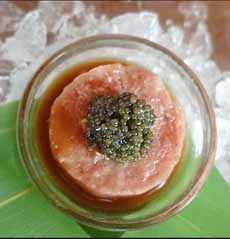
May 2005
Last Updated June 2025
|
 |
Caviar Glossary
Page 6: Lumpfish, Osetra & Other Terms With L, M, N & O
This is Page 6 of a ten-page glossary. If you’d like to suggest additional words for inclusion, or think we should consider other definitions than those we have provided, use the Contact Us link on this page. You may also enjoy one of our 60+ other food glossaries.
Click on a letter to go to the appropriate glossary page.
a b c d e f g h i j k l m n o p q r s t u v w x y z
This material is copyrighted and cannot be reproduced in whole or in part
without written permission.
LINGOTTO
Lingotto is a pressed caviar bar made for the purpose of grating or slicing. It has a more intense caviar flavor than unpressed roe does. While lingotto is not the same as pressed caviar, which is made from broken or surplus roe that is pressed and dried.
Instead, lingotto is a specific type of pressed caviar produced by Calvisius and trademarked as Calvisius Caviar Lingotto.
Lingotto is analogous to sturgeon bottarga and is used in many of the same ways. It is made from 100% Acipenser transmontanus sturgeon caviar (Pacific white sturgeon).
Lingotto is stored in a mold and aged for about two months. As a garnish on a warm dish, the warmth rehydrates the caviar and enhances the aroma.
Lingotto is Italian for ingot, which is the shape of the bar of caviar.
Here’s more about it.
|
|
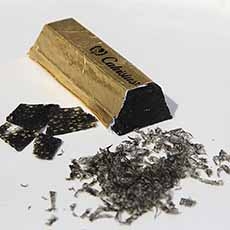
Above, the “ingot,” lingotto caviar, is shown both sliced and shaved. Below, shaved caviar on pasta (photos © Calvisius USA).
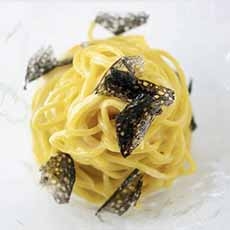
|
LUMPFISH ROE or LUMP CAVIAR
Lumpfish is a North Atlantic Ocean fish. The caviar is largely produced in Iceland. The roe is small, hard, and crunchy. The eggs are dyed black, red or yellow-gold. The food coloring is not stable, however and when used to garnish foods, the color tends to bleed (especially into moist foods like sour cream). It is readily available, and is generally used when one is seeking an inexpensive solution.
|
|

Lumpfish caviar. Photo courtesy Alpicina.com.
|
MALOSSOL
Roe does not officially become caviar until it is salted. The Russian term for “little salt,” referring to a method of delicately salting fine caviar. The less salt, the better the caviar; similarly, better-quality caviar requires less salting, so malossol indicates the best. Less salt also makes the caviar more perishable. Malossol is as little as 3.5% salt (by weight), up to 5%; compared to 10% for commercial barrel-salted caviar or 11% for supermarket lumpfish caviar. Salt preserves the freshness and also enhances the flavor.
|
|
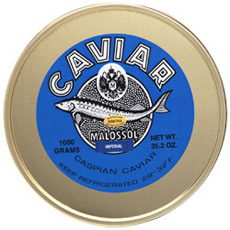
The word “malossol” on the tin indicates that little salt has been used to process the caviar. This implies a finer caviar, where the taste does not need much enhancement. Photo courtesy CaviarMore.com.
|
MASAGO or MASAGO CAVIAR or ROE
Also called capelin caviar or smelt roe: roe from the smelt fish, which lives in the northern Atlantic and Arctic oceans. The eggs are small, fluorescent, mild in flavor, have less crunc,h and are less expensive (for good reason) than the tastier tobiko. Even their color is dull, and the eggs are typically colored before packaging.
Masago roe is best used as a garnish for California rolls and other rolls, shown in the photo at the top of the page and to garnish other foods, including deviled eggs.
|
|
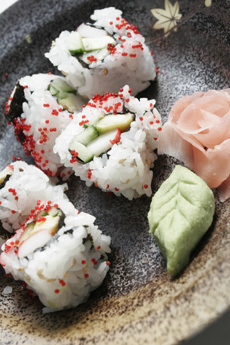
Masago, tiny eggs from the smelt, are best used as a garnish for their color. Photo by Lekyu | SXC.
|
MULLET ROE or KARASUMI
Mullet roe is not served as caviar or roe. Rather, like Italian bottarga, the roe sac is cured, dried in the sun, and pressed into a block that can be sliced for hors d’oeuvre, grated onto pasta, salads, or fish, etc. It is a delicacy and is typically eaten with a glass of saké.
Here’s more about it, and ways to use it, from Marky’s.
|
|
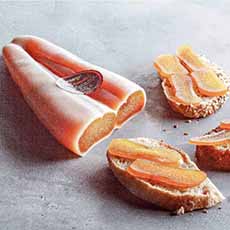
This block of mullet roe,which can be grated as a garnish, is available from Marky’s (photo Marky’s).
|
NACCARII CAVIAR
Acipenser naccarii is a cousin of Caspian caviar. The fish swam in prehistory in the rivers of what is now Spain. It has intramuscular fat, which makes the meat more flavorful. Its light grey eggs are most likened to Beluga caviar, although it is a much smaller fish. The largest beluga ever measured weighed 3,463 pounds with a length of 23.6 feet. Naccarii can grow to 100 kilos, although commercially it is farmed to 8 to 20 kilos in weight. They begin harvesting at 18 years of age. If you see Beluga caviar for sale, confirm if it is Caspian Beluga or Spanish Naccarii.
|
|
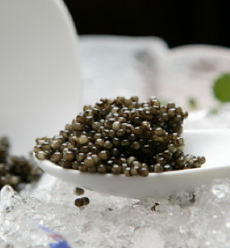
Naccarii caviar. Photo courtesy The Rogers Collection.
|
ORGANIC CAVIAR
At this time, the world’s only certified organic caviar farm, Riofrio Caviar Farm in the Sierra Nevada region of southern Spain, produces its caviar from the Adriatic sturgeon (Acipenser naccarii). Riofrio’s is considered the only true organic caviar farm because, unlike most other sturgeon fisheries, no hormones are introduced to the controlled environment to speed up the maturity rate of the fish. The fish are also contained in pens with fresh mountain water that is untreated with additives (e.g., antibacterials). It gets high grades for the quality, based on the stock selection, breeding process, clean living environment, freshness, and overall quality.
|
|
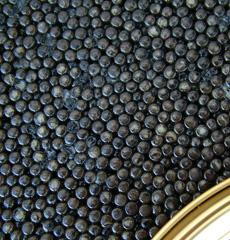
Organic caviar is available at CaviarStar.com.
|
Sold under the brand name Pure Organic Caviar, it is prepared with organic salt in the traditional malossol style.
OSETRA or OSSETRA or OSCIETRA CAVIAR
|
The Osetra sturgeon or Russian Sturgeon (Acipenser gueldenstaedtii) is a migratory fish that spawns in rivers each spring. It is a medium-sized sturgeon, and can weigh up to 440 pounds. The female does not mature to produce eggs for 12 to 15 years. The species is native to Germany’s major rivers, and the osetra sturgeon was a banquet fish for royalty throughout the Middle Ages. The caviar has a gentle pop and a light, nutty flavor (hazelnut) that pairs well with Champagne, Grüner Veltliner, and Riesling.
The word ossetra is the transcription of the Russian word осётр (osiotr), which translates into English as sturgeon.
|
|
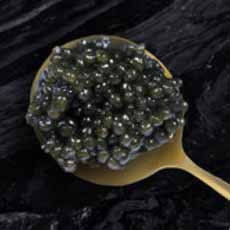
Osetra on a gold spoon. Photo courtesy Khavyar.
|
The word is variously transliterated as ascietra, asetra, osietra, ossetra and other spellings. At one time, the term “ossetra” simply referred to the Russian sturgeon species harvested for this type of caviar. For the purpose of buying caviar, though, clarify that “osetra caviar” is Russian sturgeon caviar or one of the farmed varieties (typically its cousin Acipenser baerii baerii, the Siberian sturgeon). See a longer discussion of this confusing term.
Osetra has an oilier, silkier, melts-in-your-mouth texture than Beluga. Many caviar connoisseurs prefer Osetra to Beluga (including us!). Wild Osetra caviar is harvested mainly in Russia and Iran; it is farmed around the world.* The eggs can be golden yellow (see Golden Osetra) to brownish in color, and are of medium size (about 3mm in diameter).
Osetra from the Caspian is packaged with a yellow lid. Recently, we have seen various types of farmed Baerii and other sturgeon caviar packaged in the blue tin of the Beluga.
- On the one hand, it’s confusing to the consumer who equates the blue tin with Beluga caviar.
- On the other hand, there may not be any more Beluga caviar in another few years, so why not appropriate the “trade dress?”
|
|
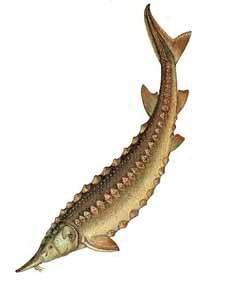
The osetra sturgeon, Acipenser gueldenstaedtii.
|
(See the note under Beluga about the 2006 ban on export of Russian caviar.)
_______________
*Asia, Bulgaria, France, Israel, Italy, and Spain are some of the larger producers.
Continue To Next Page: Caviar Terms With P
Go To The Article Index Above
Lifestyle Direct, Inc. All rights reserved. Images are the copyright of their individual owners.

|




